#Henri Gillet
Video
Pl. 28: Tapisserie, par Henri Gillet [Tapestry. by Henri Gillet] by MCAD Library
Via Flickr:
Henri Gillet (French illustrator, 1880-1920) 1900 color lithograph 26.3 cm (height) x 36 cm (width) Scanned from: Album De La Décoration. Paris: Librairie des arts décoratifs See MCAD Library's catalog record for this book. intranet.mcad.edu/library
#MCAD#MCAD Library#MCAD Special Collection#A.Calavas#Album De La Décoration#Henri Gillet#color lithographs#Decoration and ornament#Birds in art#Peacocks in art#tapestries#Plants in art#Trees in art#Landscapes#Lithography#flickr#iris#iris flowers#brambles#roses#rosa#pinus
3 notes
·
View notes
Text
Scream 6 Samara Weaving speculation/predictions
Wanted to type out my thoughts around Samara Weaving in Scream 6 and what kinda character/role she’s gonna play since she’s one of the confirmed cast that hasn’t shown up in a previous movie.
Now I’m really not the most knowledgeable on Weaving and all her roles and stuff, but the movies I’ve watched with her in it are Guns Akimbo and Ready or Not both from 2019, and I’m aware of the horror franchise? (can I call it a franchise if there’s only 2 movies) The Babysitter. I feel like it’s important to note the kinda role she plays in all three of these since they’re more of her recent and well known works, especially Ready or Not, as this film was directed by Matt Bettinelli-Olpin, Tyler Gillet and Guy Buswick, directors and writers of Scream 5, and ofc scream 6 as well.
To kinda simplify her character in Guns Akimbo, she’s crazy and violent- and although I haven’t watched the babysitter, I know she’s the main antagonist and the leader of a cult so I assume her character has more or less similar traits. And I guess these are traits that would be indicative of being cast as ghostface.
But she’s a bit different or Ready or Not, being a much more innocent character and the final girl of the movie, but at the end, after she’s been through all the bullshit she’s been through, she finds a bit of schadenfreudic humour in all of the people who tried to kill her being blown to bits- in a way that would feel a little unhinged if we didn’t follow her through all the same bullshit throughout the movie.
So I have no idea how much influence the previously mentioned directors and writer have in the casting, but it feels like if they chose Samara themselves, it was most likely influenced by them working with her in Ready or Not- as a major supporting actor from that movie (Henry Czerny) is also gonna be in Scream 6.
Like it feels like she has a lot of pontential as ghostface cause she’s a lot of fun when she plays the antagonist- but it feels like since she’s mainly known for playing antagonists that this might be another fast one being pulled on us lolol and she might be set up as a red herring character.
Similar to the way Dylan Minette, and more famously, Drew Barrymore had been cast and killed off fairly quickly, something unexpected as they were much more well known than their fellow cast members, there’s a possibility that Weaving’s character could be set up as a red herring character, using the audience’s experience with her as someone unhinged to push their suspicion further.
I’m pretty much excited anyway bc ik she’d make a sick ghostface but also is amazing at horror acting?? (Idk if I should call it that but what I mean is like- specifically acting like completely terrified and doing chase scenes and the like)
But yeah I literally just typed this all out as a bit of an infodump so if u actually read all of it I’m so suprised and very proud of u tysm <3
#scream#scream 6#scream movies#samara weaving#scream 6 predictions#scream theory#special interest infodump sorry
1 note
·
View note
Text
SCREAM FICHA A HENRY CZERNY PARA SU 6ª ENTREGA
SCREAM FICHA A HENRY CZERNY PARA SU 6ª ENTREGA
Matt Bettinelli Olpìn y Tyler Gillet continúan trabajando sin descanso en el rodaje de una nueva entrega de Scream, de la que nos van presentando a su reparto protagonista. En esta nueva entrega, se ha sabido que será la primera vez en la franquicia en la que no podremos ver a Neve Campbell.A través de Bloody-Disgusting nos anuncian que Henry Czerny se suma al reparto, actor que ya ha trabajado…

View On WordPress
0 notes
Photo



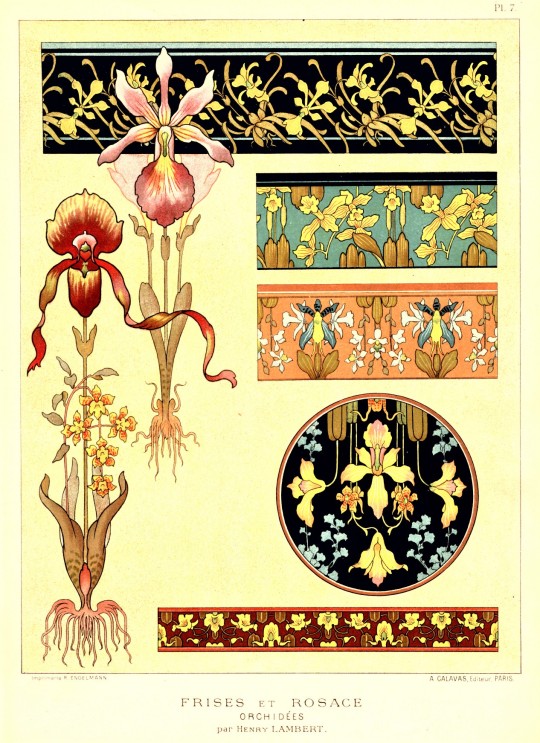

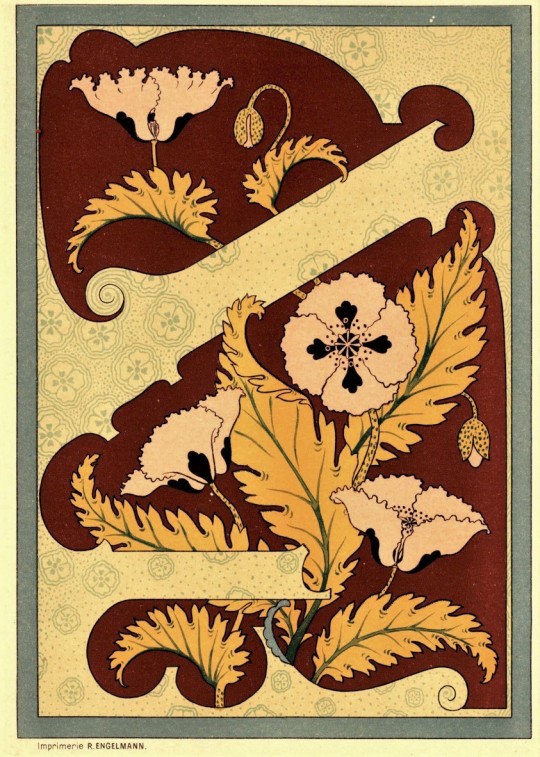

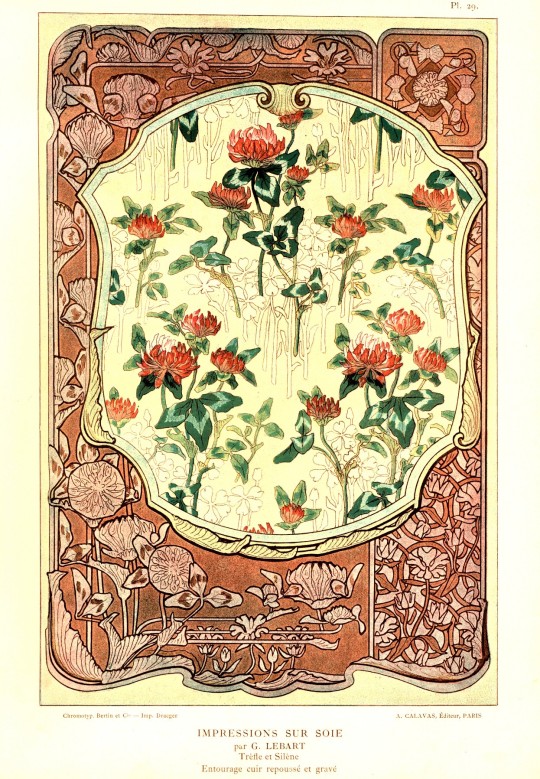

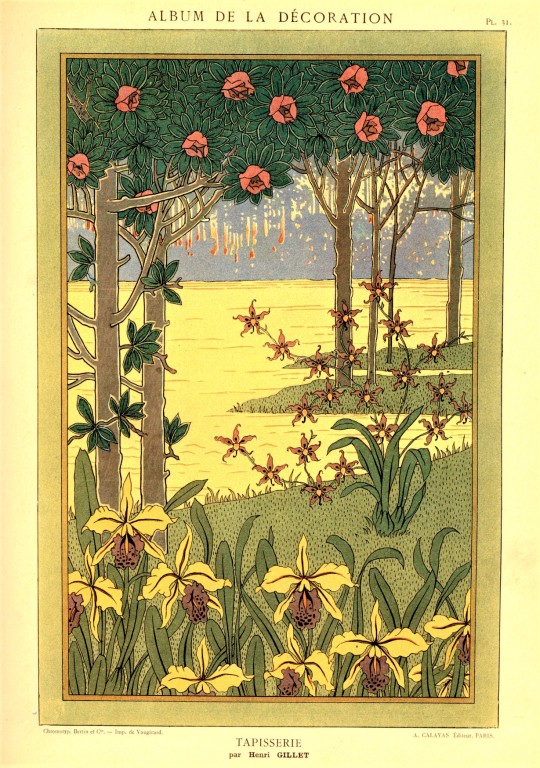
Decorative Sunday
Album de la décoration from Milwaukee Public Library
This week we are highlighting a beautiful Art Nouveau decorative art portfolio held by our friends over at Milwaukee Public Library’s Central Library. It is titled Album de la décoration edited by A. Calavas, published in 1900 in Paris by Librairie des Arts décoratifs. This portfolio features beautiful floral motifs that would have been used as inspiration for designers of various decorative objects like textiles, tapestries, ceramics, wallpaper, and paintings. There were many artists that contributed to the portfolio, including L. H. Bonvallet, Henry Lambert, Henri Gillet, and G. Lebart.
A sampling of illustrations from Album de la décoration can be found online at MCAD Library’s Flickr account.
If you are local to the Wisconsin you can see all three volumes of Album de la décoration in person at Milwaukee Public Library’s Central Library. Their MPL Special Collections department also recently started an Instagram account to highlight materials from their extensive collections including art, rarities, local history, and archives. Give them a follow at mplspecialcollections on Instagram!
View other Decorative Sunday posts.
–Sarah, Special Collections Senior Graduate Intern
#Decorative Sunday#Album de la décoration#Milwaukee Public Library#Art Nouveau#Paris#French#decorative plates#decorative arts#ornament#A. Calavas#L. H. Bonvallet#Librairie des Arts décoratifs#Henry Lambert#Henri Gillet#G. Lebart#mplspecialcollections#MPL Special Collections#art portfolio#decorative art#decoration#floral#botanical art#color lithography#peacock#Sarah Finn#sarah
1K notes
·
View notes
Photo
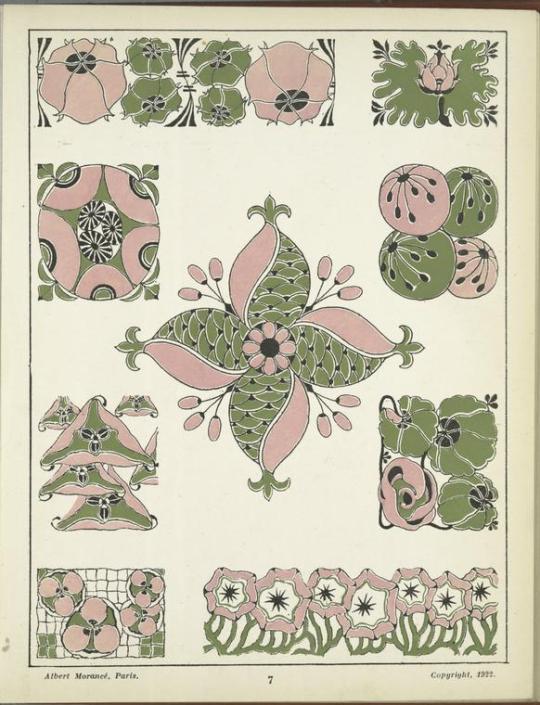





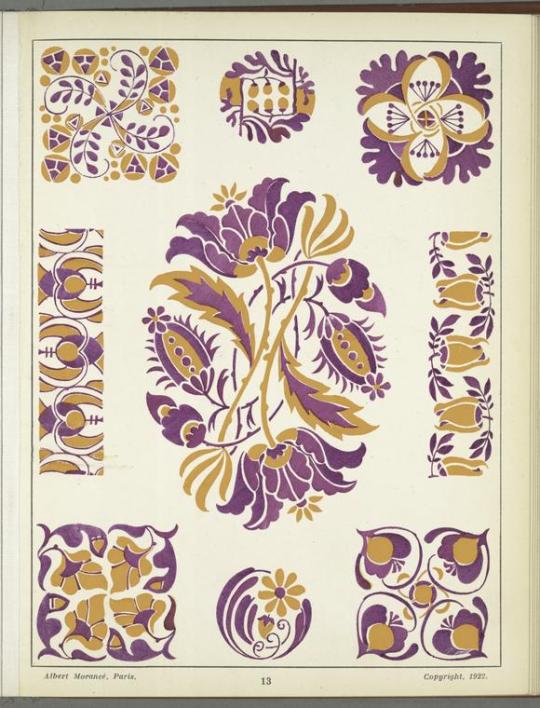

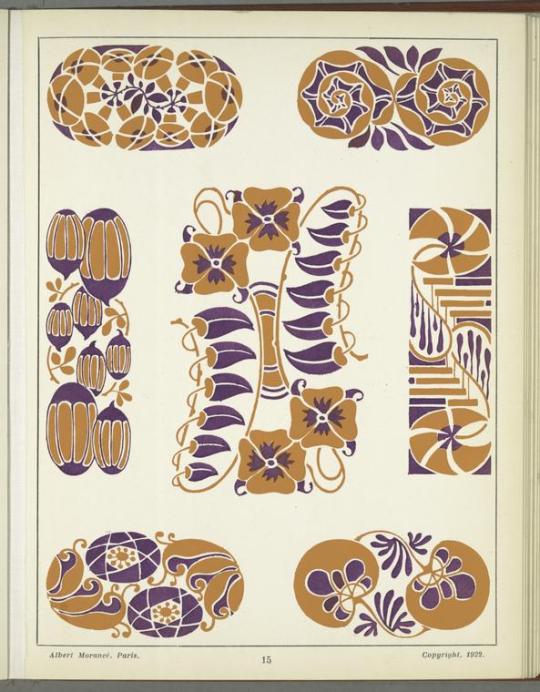

More floral Art Nouveau designs taken from ‘Vignettes Décoratives dans le Goût du Jour’ by Henri Gillet.
Published 1922? by Editions Albert Morancé.
Image and text courtesy NYPL Digital Collection
218 notes
·
View notes
Photo
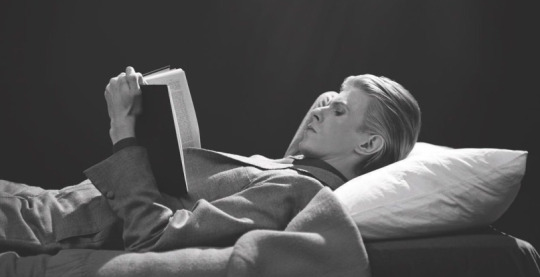
Bowie was a voracious reader. In 2013, he posted a list of his top 100 favorite reads on his Facebook page.
Interviews With Francis Bacon by David Sylvester
Billy Liar by Keith Waterhouse
Room At The Top by John Braine
On Having No Head by Douglass Harding
Kafka Was The Rage by Anatole Broyard
A Clockwork Orange by Anthony Burgess
City Of Night by John Rechy
The Brief Wondrous Life Of Oscar Wao by Junot Diaz
Madame Bovary by Gustave Flaubert
Iliad by Homer
As I Lay Dying by William Faulkner
Tadanori Yokoo by Tadanori Yokoo
Berlin Alexanderplatz by Alfred Döblin
Inside The Whale And Other Essays by George Orwell
Mr. Norris Changes Trains by Christopher Isherwood
Halls Dictionary Of Subjects And Symbols In Art by James A. Hall
David Bomberg by Richard Cork
Blast by Wyndham Lewis
Passing by Nella Larson
Beyond The Brillo Box by Arthur C. Danto
The Origin Of Consciousness In The Breakdown Of The Bicameral Mind by Julian Jaynes
In Bluebeard’s Castle by George Steiner
Hawksmoor by Peter Ackroyd
The Divided Self by R. D. Laing
The Stranger by Albert Camus
Infants Of The Spring by Wallace Thurman
The Quest For Christa T by Christa Wolf
The Songlines by Bruce Chatwin
Nights At The Circus by Angela Carter
The Master And Margarita by Mikhail Bulgakov
The Prime Of Miss Jean Brodie by Muriel Spark
Lolita by Vladimir Nabokov
Herzog by Saul Bellow
Puckoon by Spike Milligan
Black Boy by Richard Wright
The Great Gatsby by F. Scott Fitzgerald
The Sailor Who Fell From Grace With The Sea by Yukio Mishima
Darkness At Noon by Arthur Koestler
The Waste Land by T.S. Elliot
McTeague by Frank Norris
Money by Martin Amis
The Outsider by Colin Wilson
Strange People by Frank Edwards
English Journey by J.B. Priestley
A Confederacy Of Dunces by John Kennedy Toole
The Day Of The Locust by Nathanael West
1984 by George Orwell
The Life And Times Of Little Richard by Charles White
Awopbopaloobop Alopbamboom: The Golden Age of Rock by Nik Cohn
Mystery Train by Greil Marcus
Beano (comic, ’50s)
Raw (comic, ’80s)
White Noise by Don DeLillo
Sweet Soul Music: Rhythm And Blues And The Southern Dream Of Freedom by Peter Guralnick
Silence: Lectures And Writing by John Cage
Writers At Work: The Paris Review Interviews edited by Malcolm Cowley
The Sound Of The City: The Rise Of Rock And Roll by Charlie Gillete
Octobriana And The Russian Underground by Peter Sadecky
The Street by Ann Petry
Wonder Boys by Michael Chabon
Last Exit To Brooklyn By Hubert Selby, Jr.
A People’s History Of The United States by Howard Zinn
The Age Of American Unreason by Susan Jacoby
Metropolitan Life by Fran Lebowitz
The Coast Of Utopia by Tom Stoppard
The Bridge by Hart Crane
All The Emperor’s Horses by David Kidd
Fingersmith by Sarah Waters
Earthly Powers by Anthony Burgess
The 42nd Parallel by John Dos Passos
Tales Of Beatnik Glory by Ed Saunders
The Bird Artist by Howard Norman
Nowhere To Run The Story Of Soul Music by Gerri Hirshey
Before The Deluge by Otto Friedrich
Sexual Personae: Art And Decadence From Nefertiti To Emily Dickinson by Camille Paglia
The American Way Of Death by Jessica Mitford
In Cold Blood by Truman Capote
Lady Chatterly’s Lover by D.H. Lawrence
Teenage by Jon Savage
Vile Bodies by Evelyn Waugh
The Hidden Persuaders by Vance Packard
The Fire Next Time by James Baldwin
Viz (comic, early ’80s)
Private Eye (satirical magazine, ’60s – ’80s)
Selected Poems by Frank O’Hara
The Trial Of Henry Kissinger by Christopher Hitchens
Flaubert’s Parrot by Julian Barnes
Maldoror by Comte de Lautréamont
On The Road by Jack Kerouac
Mr. Wilson’s Cabinet of Wonder by Lawrence Weschler
Zanoni by Edward Bulwer-Lytton
Transcendental Magic, Its Doctrine and Ritual by Eliphas Lévi
The Gnostic Gospels by Elaine Pagels
The Leopard by Giusseppe Di Lampedusa
Inferno by Dante Alighieri
A Grave For A Dolphin by Alberto Denti di Pirajno
The Insult by Rupert Thomson
In Between The Sheets by Ian McEwan
A People’s Tragedy by Orlando Figes
Journey Into The Whirlwind by Eugenia Ginzburg
216 notes
·
View notes
Text
David Bowie's Top 100 Reads:
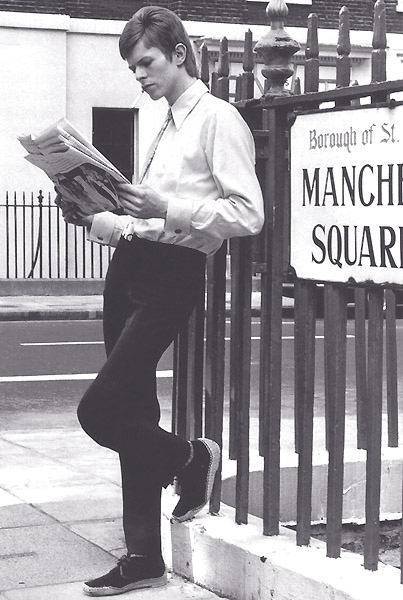
Interviews With Francis Bacon by David Sylvester
Billy Liar by Keith Waterhouse
Room At The Top by John Braine
On Having No Head by Douglass Harding
Kafka Was The Rage by Anatole Broyard
A Clockwork Orange by Anthony Burgess
City Of Night by John Rechy
The Brief Wondrous Life Of Oscar Wao by Junot Diaz
Madame Bovary by Gustave Flaubert
Iliad by Homer
As I Lay Dying by William Faulkner
Tadanori Yokoo by Tadanori Yokoo
Berlin Alexanderplatz by Alfred Döblin
Inside The Whale And Other Essays by George Orwell
Mr. Norris Changes Trains by Christopher Isherwood
Halls Dictionary Of Subjects And Symbols In Art by James A. Hall
David Bomberg by Richard Cork
Blast by Wyndham Lewis
Passing by Nella Larson
Beyond The Brillo Box by Arthur C. Danto
The Origin Of Consciousness In The Breakdown Of The Bicameral Mind by Julian Jaynes
In Bluebeard’s Castle by George Steiner
Hawksmoor by Peter Ackroyd
The Divided Self by R. D. Laing
The Stranger by Albert Camus
Infants Of The Spring by Wallace Thurman
The Quest For Christa T by Christa Wolf
The Songlines by Bruce Chatwin
Nights At The Circus by Angela Carter
The Master And Margarita by Mikhail Bulgakov
The Prime Of Miss Jean Brodie by Muriel Spark
Lolita by Vladimir Nabokov
Herzog by Saul Bellow
Puckoon by Spike Milligan
Black Boy by Richard Wright
The Great Gatsby by F. Scott Fitzgerald
The Sailor Who Fell From Grace With The Sea by Yukio Mishima
Darkness At Noon by Arthur Koestler
The Waste Land by T.S. Elliot
McTeague by Frank Norris
Money by Martin Amis
The Outsider by Colin Wilson
Strange People by Frank Edwards
English Journey by J.B. Priestley
A Confederacy Of Dunces by John Kennedy Toole
The Day Of The Locust by Nathanael West
1984 by George Orwell
The Life And Times Of Little Richard by Charles White
Awopbopaloobop Alopbamboom: The Golden Age of Rock by Nik Cohn
Mystery Train by Greil Marcus
Beano (comic, ’50s)
Raw (comic, ’80s)
White Noise by Don DeLillo
Sweet Soul Music: Rhythm And Blues And The Southern Dream Of Freedom by Peter Guralnick
Silence: Lectures And Writing by John Cage
Writers At Work: The Paris Review Interviews edited by Malcolm Cowley
The Sound Of The City: The Rise Of Rock And Roll by Charlie Gillete
Octobriana And The Russian Underground by Peter Sadecky
The Street by Ann Petry
Wonder Boys by Michael Chabon
Last Exit To Brooklyn By Hubert Selby, Jr.
A People’s History Of The United States by Howard Zinn
The Age Of American Unreason by Susan Jacoby
Metropolitan Life by Fran Lebowitz
The Coast Of Utopia by Tom Stoppard
The Bridge by Hart Crane
All The Emperor’s Horses by David Kidd
Fingersmith by Sarah Waters
Earthly Powers by Anthony Burgess
The 42nd Parallel by John Dos Passos
Tales Of Beatnik Glory by Ed Saunders
The Bird Artist by Howard Norman
Nowhere To Run The Story Of Soul Music by Gerri Hirshey
Before The Deluge by Otto Friedrich
Sexual Personae: Art And Decadence From Nefertiti To Emily Dickinson by Camille Paglia
The American Way Of Death by Jessica Mitford
In Cold Blood by Truman Capote
Lady Chatterly’s Lover by D.H. Lawrence
Teenage by Jon Savage
Vile Bodies by Evelyn Waugh
The Hidden Persuaders by Vance Packard
The Fire Next Time by James Baldwin
Viz (comic, early ’80s)
Private Eye (satirical magazine, ’60s – ’80s)
Selected Poems by Frank O’Hara
The Trial Of Henry Kissinger by Christopher Hitchens
Flaubert’s Parrot by Julian Barnes
Maldoror by Comte de Lautréamont
On The Road by Jack Kerouac
Mr. Wilson’s Cabinet of Wonder by Lawrence Weschler
Zanoni by Edward Bulwer-Lytton
Transcendental Magic, Its Doctrine and Ritual by Eliphas Lévi
The Gnostic Gospels by Elaine Pagels
The Leopard by Giusseppe Di Lampedusa
Inferno by Dante Alighieri
A Grave For A Dolphin by Alberto Denti di Pirajno
The Insult by Rupert Thomson
In Between The Sheets by Ian McEwan
A People’s Tragedy by Orlando Figes
Journey Into The Whirlwind by Eugenia Ginzburg
40 notes
·
View notes
Text
Movie Review in 700 Words or Less: Ready or Not (2019)

I’ve never been married before, but I’ve heard a lot of stories from my friends involving their rather interesting relationships with their spouses’ families. Ready or Not - directed by Matt Bettinelli-Olpin and Tyler Gillet also known as Radio Silence - explores the hardships (and perils) associated with marrying into a wealthy family. When Grace (Samara Weaving) marries into the Le Domas family, who have made millions off of selling card games and board games and acquiring professional sports teams, she learns she has to participate in a time-honored Le Domas family tradition: Game Night. The rules are simple: Grace must draw a card and whichever game is listed on the card (Old Maid, chess, etc.), that is the game she will play alongside the other Le Domas family members that include her new husband, Alex (Mark O’Brien), patriarch and matriarch, Tony and Becky (Henry Czerny and Andie MacDowell), their other children Daniel and Emilie (Adam Brody and Melanie Scrofano), Tony’s sister Helene (Nicky Guadagni) and Daniel and Emilie’s spouses, Fitch and Charity (Kristian Bruun and Elyse Levesque). When Fitch and Charity joined the family, they had to play Old Maid and chess, respectively, but when Grace draws the Hide and Seek card, she enters, unwittingly, into a game of cat and mouse.
Soon Grace is running around the creepy and cool Le Domas mansion trying to avoid being hunted down and sacrificed to Satan by her new in-laws. While Grace is the heroine of the movie, if you are expecting her to take down each member of the Le Domas clan à la assassin Beatrix Kiddo in Kill Bill or the survivalist Erin in You’re Next, that is not what Ready or Not is all about. Instead, Grace is like us, the viewer, and a lot of her choices are made out of fear and often times result in her being shot in the hand or stabbed in the shoulder. Even though Grace is not the total kickass badass many were expecting her to be, it is quite entertaining watching her outsmart the members of the Le Domas family all the while donning a bloodied wedding dress.
Ready or Not’s script is pretty solid, but my favorite part of the film is actually the characters. Each member of the Le Domas family, even the kids, are given a unique POV which influences every move they make. The film explores wealth and how it affects the people who have it. For Aunt Helene, her husband was killed and sacrificed the last time the Hide and Seek card was drawn. Her view is if she can survive losing the love of her life, so can her nephew Alex. Becky is a bit more sympathetic towards Grace since she, too, married into the family – but make no mistake, she will do anything in her power to protect her family, even if that means sacrificing Grace. Daniel and Emilie are jaded by their wealth and use alcohol and drugs, respectively, to cope. Then there’s the Tony. Tony’s wealth comes from his parents and grandparents. He was born into wealth and has greatly benefited from that wealth. He will stop at nothing to maintain that wealth – even if it means hurting his children in the process. Yeah – they’re all awful, awful people but at least there’s a method behind their madness. Love them or hate them (I kind of love them), it’s refreshing to see fleshed out characters in a movie.
It goes without saying, I absolutely freaking love this movie. If Clue and Hunger Games got together and had a baby, that baby would be Ready or Not. Samara Weaving is a great protagonist and you are rooting for her every second of the movie. Perhaps one of my favorite parts of the movie is the ending. I won’t spoil it for those of you who have not seen the film but let’s just say it’s one of the most perfect endings to a film I have seen in quite some time. If you are seeking the perfect movie for the holidays, I highly suggest this movie. I promise you will not be able to hide the smile on your face.
#ready or not#samara weaving#adam brody#henry czerny#andie macdowell#radio silence productions#kristian bruun#elyse levesque#nicky guadagni#le domas#matt bettinelli-olpin#tyler gillett#movie review#movie review in 700 words or less#clue#hunger games#kill bill#you're next
27 notes
·
View notes
Photo
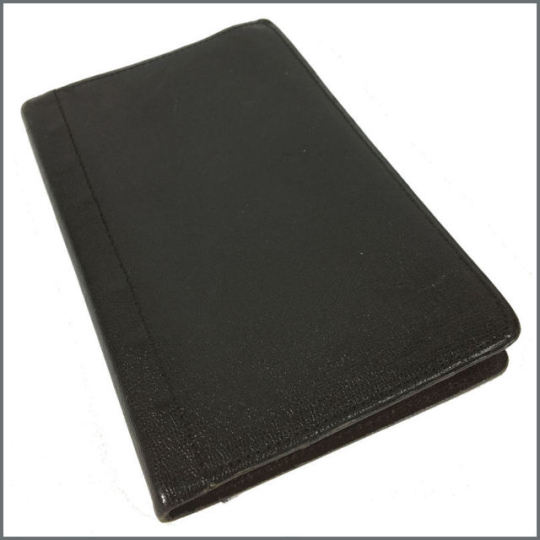


Brian Epstein’s Address & Telephone Book
A small leather bound pocket address and telephone book that was owned and used by Brian Epstein. The book dates to 1967 and it consists of 57 pages of addresses and telephone number some of which are typed, some of which are in Epstein’s hand and some which have been added by hand on his behalf. // (click HERE to view more pages from the book)
The book contains a total of 404 entries - a selection of them are listed below:
A
ATV Ltd
ABC Television Ltd
AIR London Ltd.
Tom Arnold Ltd
Neil Aspinall
Artistes Car Hire
Annabels [nightclub]
Alexander’s Restaurant
Ashley Steiner Famous [talent agency]
Al Aronowitz
Atlantic Records
Eric Andersen
Bob Anthony
B
Bryce Hanmer & Co [accounting firm]
Bedford, Okrent & Co
BBC Television Centre
BBC Broadcasting House
Al Brodax
Cilla Black
Mr. & Mrs. Tony Barrow
Mr. & Mrs Don Black
Bryan Barrett
Jack Barclay Ltd [Bentley dealership]
Peter Brown
Mr. & Mrs. B. Bullough
Mr. & Mrs J. Bullough
Miss J. Balmer
Mr. &. Mrs. Ivan Bennett
Eric Burdon
Francisco Bermudez
Lionel Bart
David Bailey
Bag O’Nails
Tony Barlow
Ray Bartell
Rodney Barnes
Bruno One Restaurant
Sid Bernstein
Kenn Brodziak
Leonard Bernstein
Al Bennett
Beverly Hills Hotel
Brian Bedford
Scotty Bower
David Ballman
Bob Bonis
Bill Buist
Arthur Buist
C
Dr. Norman Cowan
Curzon House Club
Crockfords Club
Clermont Club
Cromwellian Club
Paddy Chambers
Radio Caroline
Michael Codron
Cap-Estel Le
Mr. & Mrs. J. Cassen
Columbia Pictures Ltd
Eric Clapton
Capitol Records Mexico
Michael Cooper
Roger Curtis
Neil Christian
Maureen Cleave
Thomas Clyde
Cash Box
CBS Records Ltd
Denny Cordell
William Cavendish
Caprice Restuarant
David Charkham
Capitol Records
Columbia Broadcasting System
Bob Crewe
May Cunnell
Car Hire Co. for Lincoln
Dr. Kenneth Chesky
Capitol Records (Voyle Gilmore)
Irving E. Chezar
Danny Cleary
Bobby Colomby
Bob Casper
Andre Cadet
D
Daily Express
Disc & Music Echo
Decca Records
Bernard Delfont Ltd
Bernard Delfont
Noel Dixon
Jimmy Douglas
Chris Denning
Simon Dee
Rik Dane
Dolly’s [nightclub]
Hunter Davies
Terry Doran
Pat Doncaster
Norrie Drummond
Alan David
John Dunbar
Peter Dalton
Kappy Ditson
Robert Dunlap
Robert L. David
Diana Dors
Ivor Davis
Tom Dawes
Brandon de Wilde
Don Danneman
E
Malcolm Evans
Clive J. Epstein
Mr. & Mrs. H. Epstein
EMI Records Ltd
EMI Studios
Geoffrey Ellis
Etoile Restaurant
Tim Ellis
Terry Eaton
Kenny Everett
John East
Bob Eubanks
Esther Edwards
Ahmet Ertegun
F
Alan Freeman
David Frost
Georgie Fame
Robert Fraser
Andre Fattacini
Dan Farson
Billy Fury
Barry Finch
Marianne Faithfull
Robert Fitzpatrick
Warren Frederikson
John Fisher
Danny Fields
Francis Fiorino
G
Dr. Geoffrey Gray
Hamish Grimes
Derek Grainger
Rik Gunnell
Rik Gunnell Agency Ltd
Derrick Goodman & Co.
Peter Goldman
Christopher Gibbs
David Garrick
Geoffrey Grant
Mick Green
John P. Greenside
Michael Gillet
General Artists Corp.
John Gillespie
Voyle Gilmore
George Greif
Ren Grevatt
Milton Goldman
M. Goldstein
Gary Grove
Henry Grossman
H
Mr. & Mrs. Berrell Hyman
Doreen Hyman
Mr. & Mrs. Basil J. Hyman
Mrs. A. Hyman
Steve Hardy
H. Huntsman & Son Ltd
Simon Hayes
Frankie Howerd
Henry Higgins
Chris Hutchins
Tony Howard
Wendy Hanson
Marty Himmel
Casper Halpern
John Heska
Ricky Heiman
Joe Hunter
Ty Hargrove
Hullabaloo.
Walter Hofer
J
M.A. Jacobs & Son
David Jacobs [lawyer]
Dick James Music Ltd
Mr. & Mrs. D. James
Mick Jagger
Brian Jones
Michael Jeffries
Drummond Jackson
David Jacobs [d.j.]
Brian Joyce
Gerry Justice
K
Gibson Kemp
Johnathan King
Mr. & Mrs Maurice Kinn
Kingsway Recording Studios
Ashley Kozac
Kafetz Camera Ltd.
Reg King
Andrew Koritsas
Ed Kenmore
Walker Kundzicz
John Kurland
Murray Kauffman
L
Larry Lamb
Martin Landau
Kit Lambert
Dick Lester
Mr. & Mrs. Vic Lewis
Tony Lynch
Radio London
Mike Leander
John Lyndon
Bernard Lee
Kenny Lynch
Denny Laine
Lomax Alliance
Ed Leffler
David G. Lowe
Richard W. Lean
Goddard Lieberson
Laurie Records
Liberty Records
London Records
Alan Livingston
M
Melody Maker
Peter Murray
Keith Moon
Mr. & Mrs. G. Martin
Mr. & Mrs. Brian Matthew
Midland Bank Limited
Vyvienne Moynihan
Gerry Marsden
Ian Moody
Michael McGrath
Cathy McGowan
Mr. & Mrs. J. McCartney
Albert Marrion
Robin Maughan
Peter Maddok
Gordon Mills
Brian McEwan
John Mendell Jnr.
Marshall Migatz
Fred Morrow
Chruch McLaine
Vincent Morrone
Jeffrey Martin Co.
Gavin Murrell
Dean Martin
Gordon B. McLendon
Sal Mineo
Scott Manley
Bernard Mavnitte
Verne Miller
N
John Neville
Joanne Newfield
Tommy Nutter
Francisco Neuner
Tatsuji Nagasima
New Musical Express
NEMS Enterprises Ltd
Graham Nash
Nemperor Artists Ltd
Louis Nizer
Bob Nauss
Gene Narmore
O
George H. Ornstein
Olympic Sound Studios
A. L. Oldham
Myles Osternak
Roy Onsborg
P
Col. Tom Parker
Jerry Pam
Plaza Hotel
PAN AM. rep
Bob Perlman
Allen Pohju
Robert H. Prech
John Pritchard
Prince Of Wales Theatre
Don Paul
Sean Phillips
Jon Pertwee
Ricki Pipe
Dr. D. A. Pond
David Puttnam
David Puttnam Associates
Tom Parr
Harry Pinsker
Kenneth Partridge
Larry Parnes
Priory Nursing Home
Viv Prince
Steve Paul
R
Radnor Arms [pub]
Leo Rost
Keith Richard
Record Mirror
Dolly Robertson-Ward
Charles Ross
Rules Restuarant
Marian Rainford
Bobby Roberts
Bill Rosado
S
Vic Singh
Speakeasy [club]
Simon and Marijke
Simon Shops
Judith Symons
Keith Skeel
Tony Sharman
Simon Scott
Barrie Summers
John Singleton
Squarciafichi
Don Short
Dr. Walter Strach
Walter Shenson
John Sandoe Ltd
Bobby Shafto
Harry South
Brian Sommerville
Robert Stigwood
David Shaw
Chris Stamp
Aaron Schroeder
Stephen, Jacques & Stephen [law firm]
Leo Sullivan
Gene Schwann
Herb Schlosser
Gary Smith
Jim Stewart [co-founder, Stax Records]
John Simon
Jerry N. Schatzberg
Lex Taylor
Robert Shoot
Lauren Stanton
St. Regis Hotel
Eric Spiros
Howard Soloman
T
Taft Limousine Corp
[Sidney] Traxler (lawyer)
T.W.A. Ken S. Fletcher [director, public relations, TWA]
Derek & Joan Taylor
T.W.A. (Victor Page)
Martin Tempest
Evelyn Taylor
Twickenham Studios
Kenneth Tynan
Alistair Taylor
F. T. Turner & Son Ltd.
R. S. Taylor
Michael Taylor
George Tempest
Norm Talbott
U
United Artists Corp Ltd
U.P.I.
V
Klaus & Christine Voormann
V.I.P. Travel Ltd
W
Mark Warman
Gary Walker
Robert Whitaker
Peter Watkins
Peter Weldon
Mrs. Freda Weldon
Alan Warren
Orson Welles
Sir David Webster
Alan Williams
Dennis Wiley
Terry Wilson
Nathan Weiss
Norman Weiss
Gerry Wexler
Y
Murial Young
Bernice Young
Z
Peter Zorcon
79 notes
·
View notes
Text
Ready or Not Review

Ready or Not comes from the creators of V/H/S, Devil’s Due, and Southbound and is directed by Matt Bettinelli-Olpin & Tyler Gillet with the script written by Guy Busick and R. Christopher Murphy. The film stars Samara Weaving, Mark O’Brien, Adam Brody, Henry Czerny, and Andie MacDowell. The film follows a recently wed bride Grace (Weaving) who marries into a rich family and soon ends up being hunted by her new in-laws in a sinister game of hide and seek. The concept for this story is ingenious and I give credit to the writers for coming up with this unique, fun, and twisted tale on what we used to play when we were children. Ready or Not is a welcome surprise into the horror genre that mixes elements from past films with some excellent black comedy that makes this film a late summer gem.
Samara Weaving is awesome and kicks so much ass in this film. This actress is a star and is currently making a name for herself in the genre space with this film, The Babysitter, and Mayhem. If you haven’t checked either of those films out do so, she shines bright in those films. Weaving continues to do no wrong and shines in all the scenes she’s in displaying a wide variety of emotions from start to finish. The supporting cast that round out Weaving are enjoyable as well and each have their moments to shine in this film with some having great comedic moments.
Ready or Not moves at a fast pace and it doesn’t stop once the action gets going. The story is tight and never meanders or feels like the film is slowing down at any points. I appreciate what the directors and writers did with that as this could have been a concept that proved silly and campy, but the filmmakers made this film better than it should be. Any real issues with this film are miniscule as I had a blast with Ready or Not from start to finish. Ready or Not is sure to be a crowd pleaser and possible cult hit for those that watch it and for genre fans like myself it’s refreshing to see a new and fun concept work so well in the horror space.
#ready or not#matt bettinelli-olpin#tyler gillett#guy busick#r christopher murphy#samara weaving#mark o'brien#adam brody#henry czerny#andie macdowell#hide and seek#black comedy#horror film#ready or not movie#film review#film tumblr
17 notes
·
View notes
Text
SHE WAS A SMELLY
BIATCH AS WELL
GEORGE GILLET TOM HICKS
To JOHN HENRY WOW THATS DEEP
TO GORDIES IN NEWS THEN UNITED
GLAZIERS HA HA HA HA HA YOUR OVER
LIVERPOOL ALREADY
0 notes
Text
An extract from ‘Matisse: The Chapel at Vence’
“The artist’s conscience is a pure, faithful mirror in which he must be able to reflect his work every day … The abiding responsibility of the creator towards himself and towards others is not a hollow concept: by assisting the universe to construct itself the artist maintains his dignity.”
~ Letter from Henri Matisse to André Verdet, 1954
Introduction: The Chapel of the Rosary, Vence
Matisse compared the Chapel of the Rosary in Vence to a book whose pages are to be inscribed using brushes and black Indian ink on white ceramic tiles, enhanced by the colour of the stained-glass windows. Beginning in 1932 with an edition of the poems of Mallarmé, Matisse illustrated a number of different books; their pages all share the same characteristic architectural space constructed through the artist’s choice of typography and graphic design – pen and Indian ink, or sepia and cut paper coloured with gouache. As in the chapel, the pages of these books are overlaid with patterns and this serves to accentuate their luminous quality and their presence.
In creating the chapel, Matisse went beyond the specific religious ritual for which it is the framework: he was also motivated by his personal view of the archetypes represented by light and space. The boundless white inside the chapel represented the infinite, as well as man’s spiritual dimension and mystical nature. The chapel is an enclosed space built around the idea of man’s potential salvation; this is symbolised by the disproportionate height and verticality of the chapel’s bell tower, which extends upwards towards the sky, and by the brightness from the sky that enters the chapel through its windows. The building represents an embodied metaphor for our efforts to escape from material and spiritual constraints and return to a state of transcendence; it does this without destroying the identity of the person who comes to it to pray or to visit – instead it assuages their suffering.
Vence
In March 1943 an area of Nice was destroyed by bombing. Fearing that some of the city’s blocks of flats would be taken over by the Germans, Matisse temporarily abandoned his studio apartment in the Régina building in Nice’s Cimiez neighbourhood and moved to Vence, a village in the countryside just outside the city. There he occupied a villa named Le Rêve, in which he remained until the end of 1948. As he did with all his homes, Matisse also used the villa as a studio. He produced a large body of work there, work that was noteworthy for the originality of the technique used, and in particular Matisse’s method of composing his image by laying out the colour in flat planes. This technique characterises the so-called ‘Vence period’ in Matisse’s work. As usual, Matisse was completely dedicated to his work at this time, and organised his day around sessions of drawing and painting. The garden of Le Rêve was a major source of inspiration. The artist filled many notebooks with drawings of plant forms, and he would work on a pattern and its structure until it became a part of the fabric of his visual language. Through the simplification of their graphic forms, leaves and branches became ‘signs’. He said: ‘An artist must take possession of Nature. He must identify himself with Nature’s rhythm through applied effort; this will help him acquire the mastery which, later, will enable him to express himself in his own language.’ Matisse viewed nature as the guardian of the secret of creation. He wished to be penetrated by the beauty of nature so that his art might be lively yet at the same time accessible to others.
In addition to his studies of nature, the serious operation Matisse had undergone in 1941 and his encounter in 1942 with Monique Bourgeois, who was at the time a nurse but was later to become a Dominican nun, added spiritual depth to his art and inspiration while he was in Vence. “At the moment I go every morning to say my prayers, pencil in hand; I stand in front of a pomegranate tree covered in blossom, each flower at a different stage, and I watch their transformation. Not in fact in any spirit of scientific enquiry, but filled with admiration for the work of God. Is this not a way of praying? And I act in such a way (although basically I do nothing myself as it is God who guides my hand) as to make the tenderness of my heart accessible to others.”
The development of his drawing, and the amplification of his expressiveness through colour and design, created a new pictorial realm. Particularly during 1947, Matisse’s interpretation of interiors that were open to the outside world via the window foreshadowed the approach he was to adopt within the chapel.4 With their coloured motifs, the chapel’s stained-glass windows use the contrast between transparency and opacity to mediate the relationship between the inner religious world and the world outside. Additionally, the representations of St Dominic, the Virgin and Child and the Way of the Cross are simplified to such a degree that their lines have become ‘signs’. With the chapel, Matisse’s work acquired a new dimension, infused with far greater awareness of the spiritual grandeur of artistic creation of all kinds. “Most painters … look for an external light to see clearly into their own nature. Whereas the artist or the poet possesses an inner light that transforms objects, creating a new world with them, a sentient, organised and living world, a sure sign of divinity in itself, the reflection of divinity.”
Matisse moved into the Villa Le Rêve in 1943. In February the historian of art and literature, Louis Gillet, recorded the artist’s words, as reported above. During this wartime period, while recovering from his operation of 1941, Matisse was soothed and supported by the landscape of Vence and the plants in his garden. Destiny was to lead him to create the Chapel of the Rosary for the Dominican nuns at the nearby Foyer Lacordaire.
~
Marie-Thérèse Pulvenis de Sélignyor · 3. March 2014.
0 notes
Photo

If you’re going to join a book club, why not Bowie’s? His favorite 100 books in no particular order:
Interviews With Francis Bacon by David Sylvester
Billy Liar by Keith Waterhouse
Room At The Top by John Braine
On Having No Head by Douglass Harding
Kafka Was The Rage by Anatole Broyard
A Clockwork Orange by Anthony Burgess
City Of Night by John Rechy
The Brief Wondrous Life Of Oscar Wao by Junot Diaz
Madame Bovary by Gustave Flaubert
Iliad by Homer
As I Lay Dying by William Faulkner
Tadanori Yokoo by Tadanori Yokoo
Berlin Alexanderplatz by Alfred Döblin
Inside The Whale And Other Essays by George Orwell
Mr. Norris Changes Trains by Christopher Isherwood
Halls Dictionary Of Subjects And Symbols In Art by James A. Hall
David Bomberg by Richard Cork
Blast by Wyndham Lewis
Passing by Nella Larson
Beyond The Brillo Box by Arthur C. Danto
The Origin Of Consciousness In The Breakdown Of The Bicameral Mind by Julian Jaynes
In Bluebeard’s Castle by George Steiner
Hawksmoor by Peter Ackroyd
The Divided Self by R. D. Laing
The Stranger by Albert Camus
Infants Of The Spring by Wallace Thurman
The Quest For Christa T by Christa Wolf
The Songlines by Bruce Chatwin
Nights At The Circus by Angela Carter
The Master And Margarita by Mikhail Bulgakov
The Prime Of Miss Jean Brodie by Muriel Spark
Lolita by Vladimir Nabokov
Herzog by Saul Bellow
Puckoon by Spike Milligan
Black Boy by Richard Wright
The Great Gatsby by F. Scott Fitzgerald
The Sailor Who Fell From Grace With The Sea by Yukio Mishima
Darkness At Noon by Arthur Koestler
The Waste Land by T.S. Elliot
McTeague by Frank Norris
Money by Martin Amis
The Outsider by Colin Wilson
Strange People by Frank Edwards
English Journey by J.B. Priestley
A Confederacy Of Dunces by John Kennedy Toole
The Day Of The Locust by Nathanael West
1984 by George Orwell
The Life And Times Of Little Richard by Charles White
Awopbopaloobop Alopbamboom: The Golden Age of Rock by Nik Cohn
Mystery Train by Greil Marcus
Beano (comic, ’50s)
Raw (comic, ’80s)
White Noise by Don DeLillo
Sweet Soul Music: Rhythm And Blues And The Southern Dream Of Freedom by Peter Guralnick
Silence: Lectures And Writing by John Cage
Writers At Work: The Paris Review Interviews edited by Malcolm Cowley
The Sound Of The City: The Rise Of Rock And Roll by Charlie Gillete
Octobriana And The Russian Underground by Peter Sadecky
The Street by Ann Petry
Wonder Boys by Michael Chabon
Last Exit To Brooklyn By Hubert Selby, Jr.
A People’s History Of The United States by Howard Zinn
The Age Of American Unreason by Susan Jacoby
Metropolitan Life by Fran Lebowitz
The Coast Of Utopia by Tom Stoppard
The Bridge by Hart Crane
All The Emperor’s Horses by David Kidd
Fingersmith by Sarah Waters
Earthly Powers by Anthony Burgess
The 42nd Parallel by John Dos Passos
Tales Of Beatnik Glory by Ed Saunders
The Bird Artist by Howard Norman
Nowhere To Run: The Story Of Soul Music by Gerri Hirshey
Before The Deluge by Otto Friedrich
Sexual Personae: Art And Decadence From Nefertiti To Emily Dickinson by Camille Paglia
The American Way Of Death by Jessica Mitford
In Cold Blood by Truman Capote
Lady Chatterly’s Lover by D.H. Lawrence
Teenage by Jon Savage
Vile Bodies by Evelyn Waugh
The Hidden Persuaders by Vance Packard
The Fire Next Time by James Baldwin
Viz (comic, early ’80s)
Private Eye (satirical magazine, ’60s – ’80s)
Selected Poems by Frank O’Hara
The Trial Of Henry Kissinger by Christopher Hitchens
Flaubert’s Parrot by Julian Barnes
Maldodor by Comte de Lautréamont
On The Road by Jack Kerouac
Mr. Wilson’s Cabinet of Wonders by Lawrence Weschler
Zanoni by Edward Bulwer-Lytton
Transcendental Magic, Its Doctine and Ritual by Eliphas Lévi
The Gnostic Gospels by Elaine Pagels
The Leopard by Giusseppe Di Lampedusa
Inferno by Dante Alighieri
A Grave For A Dolphin by Alberto Denti di Pirajno
The Insult by Rupert Thomson
In Between The Sheets by Ian McEwan
A People’s Tragedy by Orlando Figes
Journey Into The Whirlwind by Eugenia Ginzburg
If the title’s in bold we’ve got a copy of it in store. Pretty much everything else is orderable at some discount to it’s cover price. This guy had good taste. And yes, there is an Antonio Banderas version of that ‘Read’ poster hanging on our Main St bathroom door. Price of admission, folks.
3 notes
·
View notes
Link
Notes and References
This item contains 46 references.
Endnotes
1 This reference contains 7 citations:
2 Lerdahl and Jackendoff (1981)
3 This reference contains 2 citations:
4 This reference contains 5 citations:
5 This reference contains 3 citations:
9 This reference contains 2 citations:
10 This reference contains 11 citations:
11 This reference contains 3 citations:
12 This reference contains 2 citations:
13 This reference contains 6 citations:
Lavere's liner notes to the CBS Complete Recordings (1990)
'Robert Johnson, 1938'
Marcus (1982)
Charters 1967/1977
Evans 1982
Lomax 1993
Oliver 1960/1994
Floyd 1995, p. 3
ibid., p. 10
Keil 1966, pp. 54-8, 76
Oakley 1976, p. 176
Baraka 1963, pp. 106-9
Oakley 1976, p. 88f
Titon 1977, p. 63
Marcus 1982, p. 32
Oakley 1976, p. 220
Keith Richard in Robert Johnson, The Complete Record- ings liner notes
Chester (1970)
Middleton 1990, p. 269f
The Civil Rights Act of 1875
1883
1896
1882
1903
1915 the Klu Klux Klan
1890
1917
Carroll and Noble 1977, pp. 254, 256, 293ff
Marable 1984, p. 7f
Endnote 3 above
Hanbone Wille Newbern was playing 'Roll and Tumble Blues' as early as 1917 (Calt 1988)
1929
Yazoo L1073
Henry and Bragg 1992
Supreme's 1963
1978, p. 6
Hodier's Freudian explanation of swing (1956, p. 196) ��
blues (1991a, p. 20)
Keil on the rhythmic effect of the calculated stutter (1966, p. 125)
1987, p. 213
1990, pp. 186-96
References
Borneman, E. 1959. 'The roots of jazz', in Jazz, eds N. Hentoff and A. J. McCarthy (New York)
Calt, S. 1988. Liner notes to The Roots of Robert Johnson, Yazoo L1073
Carroll, P. N. and Noble, D.W. 1977. The Free and the Unfree, Penguin
Charters, S. 1991. Blues Makers (New York)
This reference contains 2 citations:
Collier, J. L. 1981. The Making of Jazz, a Comprehensive History (London)
Evans, D. 1982. Big Road Blues, Tradition and Creativity in the Folk Blues (New York)
This reference contains 2 citations:
Floyd, S. 1995. The Power of Black Music, Interpreting It's History from Africa to the United States (Oxford)
Gates, H. L. 1989. The Signifying Monkey, a Theory of African-American Literary Criticism (Oxford)
George, N. 1989. The Death of Rhythm and Blues (London)
Gillet, C. 1970 (1983). The Sound of the City (London)
Heilbut, A. 1987. The Gospel Sound, Good News and Bad Times (New York)
Henry, L., Bragg, M. 1992. A History of Funk, The South Bank Show, London Weekend Television, 12 January 1992
Hodeir, A. 1956. Jazz, Its Evolution and Essence (London)
Keil, C. 1966. Urban Blues (Chicago)
Lavere, S. 1990. Liner notes to Robert Johnson, the Complete Recordings, CBS 467246 2
Lerdahl, F. and Jackendoff, R. 1981. 'On the theory of grouping and metre', Music Quarterly, Fall, pp. 479-506
Levi Strauss, C. 1962 (1966). La Pensée Sauvage, translated as The Savage Mind (London)
Lomax, A. 1993. The Land Where the Blues Began (London)
Marable, M. 1984. Race, Reform and Rebellion, the Second Reconstruction in Black America (London)
Marcus, G. 1982. Mystery Train, first edition 1976 (London)
Maultsby, P. K. 1990. 'Africanisms in African-American music' in Africanisms in American Culture, ed. J. E. Holloway (Indiana)
Middleton, R., 1990. Studying Popular Music (Buckingham)
Oakley, G. 1976. The Devil's Music (London)
Oliver, P. 1960. Blues Fell this Morning (Cambridge)
Shaw, A. 1978. Honkers and Shouters, the Golden Years of Rhythm and Blues (New York)
Sidran, B. 1971. Black Talk (New York)
Small, C. 1987. Music of a Common Tongue, Survival and Celebration in Afro-American Music (London)
Sterne, L. 1767 (1979). The Life and Opinions of Tristram Shandy, Gentleman (London)
Tagg, P. 1989. 'Black music', 'Afro-American music' and 'European music' in Popular Music, 8/3, pp. 285-98 (Africa Issue)
Chester, A. 1970. 'Second thoughts on a rock aesthetic, The Band', in New Left Review 67
Rock, Pop and the Written Word, eds. S. Frith and A. Goodwin, 1990 (London)
Fanon, F. 1952 (1970). Black Skin White Masks (London)
1956 (1967) 'Racism and Culture', speech to the First Congress of Negro Writers and Artists in Paris in Towards The African Revolution, trans. Haakon Chevalier, London
0 notes
Photo
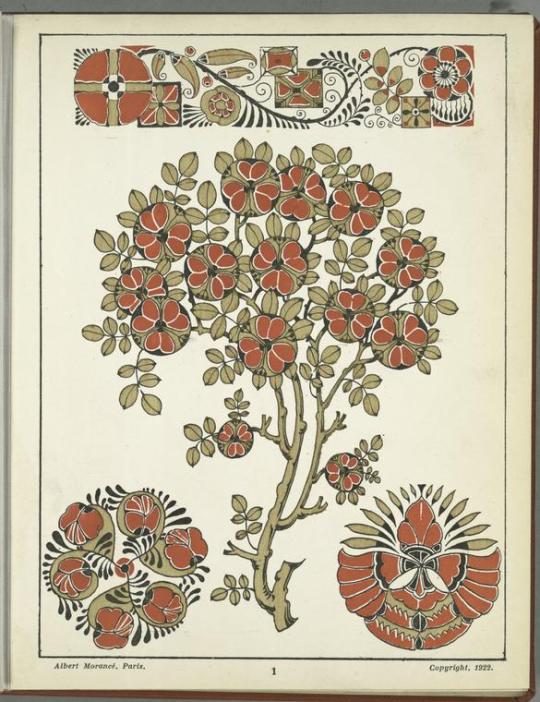


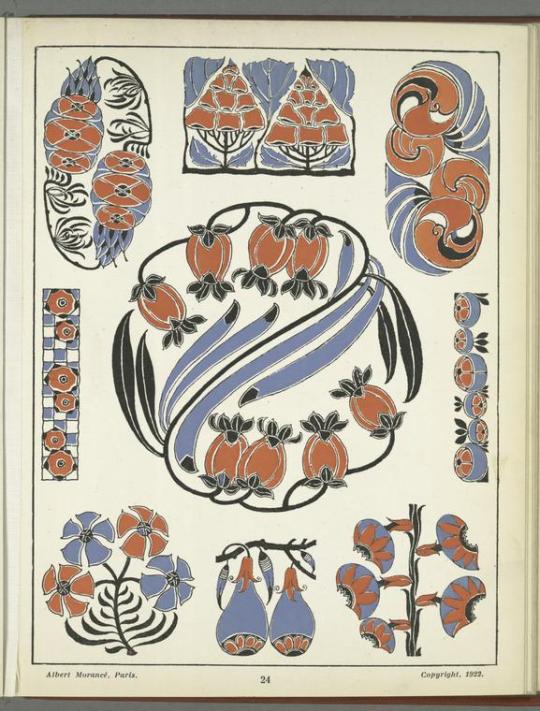


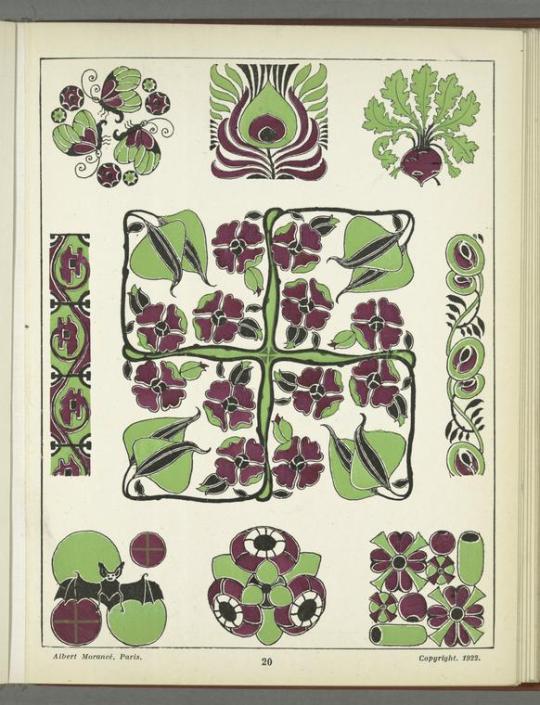

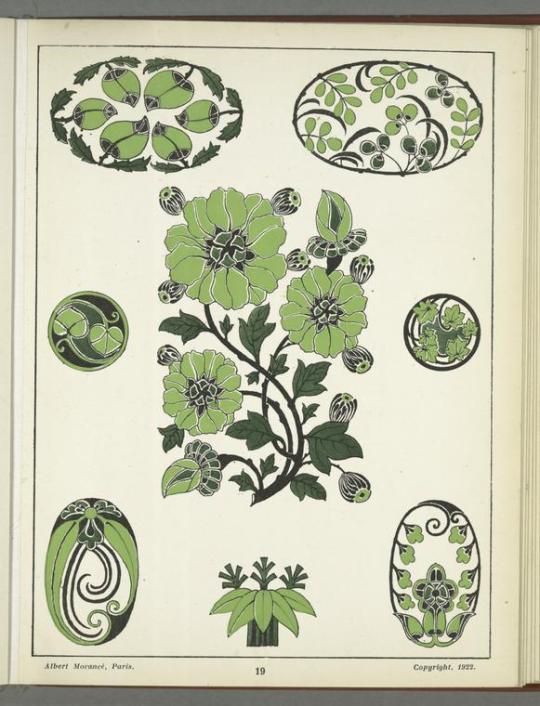

Floral Art Nouveau designs taken from ‘Vignettes Décoratives dans le Goût du Jour’ by Henri Gillet.
Published 1922? by Editions Albert Morancé.
Image and text courtesy NYPL Digital Collection
170 notes
·
View notes
